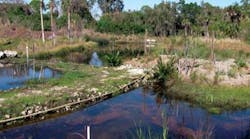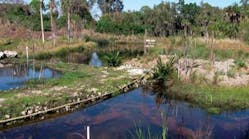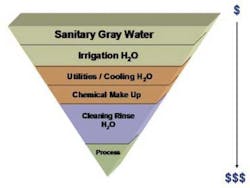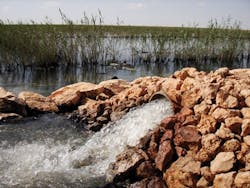By Robert Jeyaseelan
A new odor control technology was applied to hydrogen sulfide odors in a sludge thickener at the Figueroa Avenue Water Pollution Control Facility in Yuma, AZ. In a recent 24-hour field test, H2S levels as high as 70 parts per million were essentially eliminated during the test period.
"This is the most malodorous part of the plant," said Jeremy McCall, supervisor of the Figueroa Avenue WPCF. "The technology operated as designed, and the test documented that the fogging system was effective in removing H2S."
The Figueroa Avenue WPCF is the largest and oldest of three treatment plants serving Yuma, population about 100,000, located in the Southwest corner of Arizona near the Mexican and California borders.
The facility is designed for 12 mgd and currently treats about 7 mgd, primarily from residential customers, although several industries contribute flow as well. Connected population is about 75,000.
Two influent streams feed the plant through a common interceptor. One, consisting of about 65 percent of the plant's throughput, is treated with ferrous chloride some 30 miles upstream of the plant to counter odors. The second stream enters the plant without any pre-treatment for odors.
The treatment process train consists of a headworks, grit removal, primary basins, activated sludge with fine bubble diffusion, and secondary clarification. After disinfection with sodium hypochlorite and de-chlorination with sodium bisulfate, the treated effluent is discharge to the Colorado River.
Primary and waste activated solids are digested in a pair of anaerobic digesters, and then hauled as a liquid to area farm fields for sub-surface injection. Prior to digestion, the primary solids are thickened in an enclosed gravity sludge thickener, which was the site of the odor control demonstration. The thickener is 40 feet in diameter, and the dome cover height is 10 feet above the concrete wall.
McCall said the H2S odors build up in the collections system and then are released as a blower pulls air out of the thickener and exhausts it to the atmosphere.
Each primary clarifier sequentially pumps into the thickener for a total of about 30 minutes. Then the thickener pumps to the digester. The process is repeated throughout the day and night and there is a noticeable spike in H2S levels when the thickener pump is energized.
Fogging System Test
Originally the test of the OHxyPhogg™ oxidant fogging system, marketed by Parkson, was to be conducted in the enclosed headspace of the plant's primary clarifiers, but the odors in the gravity thickener were even more concentrated and offered a more rigorous test of the technology.
Prior to the demonstration, the aluminum covers over the gravity thickener were secured and a canvas tarp placed across the access door to prevent outside conditions from entering the headspace. The exhaust blower remained off for the entire trial. Plant personnel placed an OdaLog odor monitor inside the thickener to establish a baseline for H2S levels.
Two Parkson OHxyPhogg V-150 units, each equipped with two nozzles, were positioned inside the sludge thickener. These units measure 43 inches (L) by 35 inches (W) by 45 inches (H), and require only a 110 VAC power source, and a potable water line capable of outputting 10 gallons per hour at 20 psi.
H2S monitors were placed at the sludge inlet - the source of the odors - and approximately 150 feet away at the exhaust pipe. Readings were taken at hourly intervals, beginning at mid-morning on the ninth, and running through mid-morning on the second day.
The 24-hour period was typical of normal operation of the sludge thickener, with H2S reaching peaks of 60 and 70 ppm , and two additional hourly readings exceeding 30 ppm. Temperatures inside the thickener reached 120 degrees F.
Once the OHxyPhogg unit was energized, the outlet H2S levels decreased to virtually zero within 15 minutes. Plant personnel noticed the absence of H2S immediately. At the outlet point, H2S levels were measured at less than 1 ppm throughout the two-day test and were essentially undetectable. (See attached chart).
A white paper prepared by Parkson and the city following the test confirmed that the oxidant fogging technology is effective for this application.
"We can state that the objectives of the pilot trial were accomplished. The pilot test unambiguously established, both objectively and subjectively, that the OHxyPhogg unit can reduce H2S levels to virtually zero," the report concluded.
An odor control system had been tried in this space before. McCall explains that years ago the city had a chemical scrubbing system installed, but that since has been removed, with only the exhaust piping still in place.
McCall says the demonstration did not interfere with plant operations.
"I wasn't sure to what extent the test would require our personnel or resources," he said. "But those requirements were minimal. They only needed a 110 electrical connection and a fresh water source, and their personnel handled all the rest. It was simple, and quiet."
Technology Options
OHxyPhogg systems are customizable to meet varying installation requirements, and can be installed indoors or out of doors. Five different unit sizes are available and multiple nozzles can be introduced based on application requirements.
Unlike other odor control technologies, these systems do not require the extraction and post-treatment of foul air. They treat offensive odors in place, reducing energy costs, without the use of chemicals. The technology is effective in enclosed or partially enclosed odorous areas up to 60,000 cubic feet. It also kills biofilm, breaks down grease, and reduces surface corrosion.
WW
About the Author: Robert Jeyaseelan is a Commercial Director at Parkson Corporation and is leading the commercialization of odor technologies from the Fort Lauderdale, Florida office. For more information: www.parkson.com
More WaterWorld Current Issue Articles
More WaterWorld Archives Issue Articles






